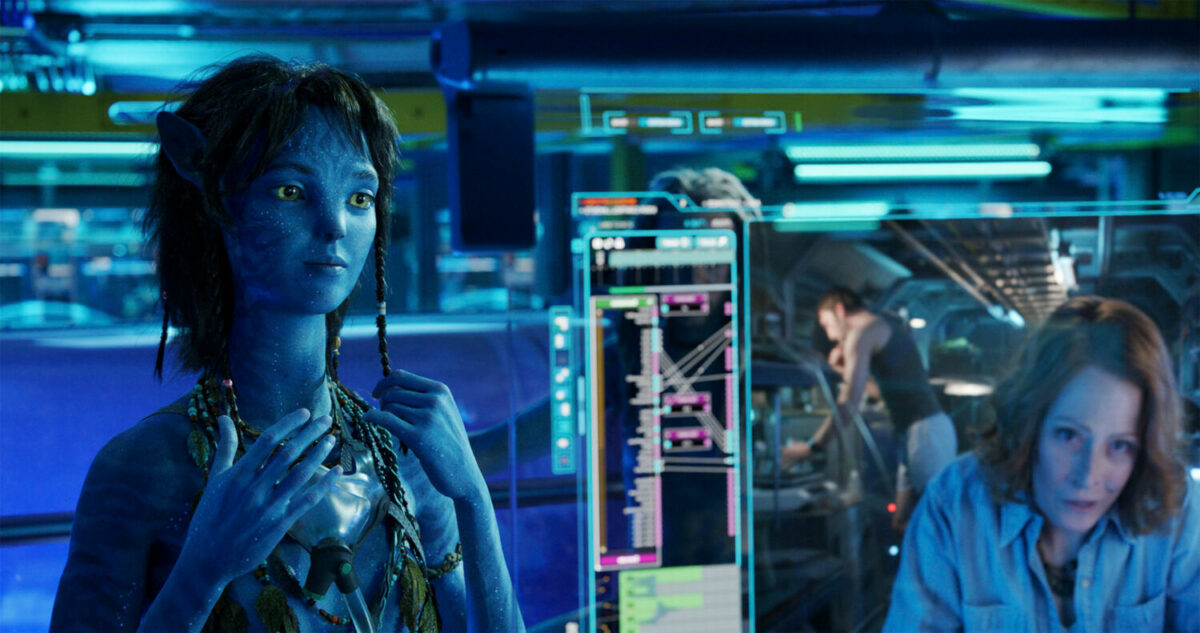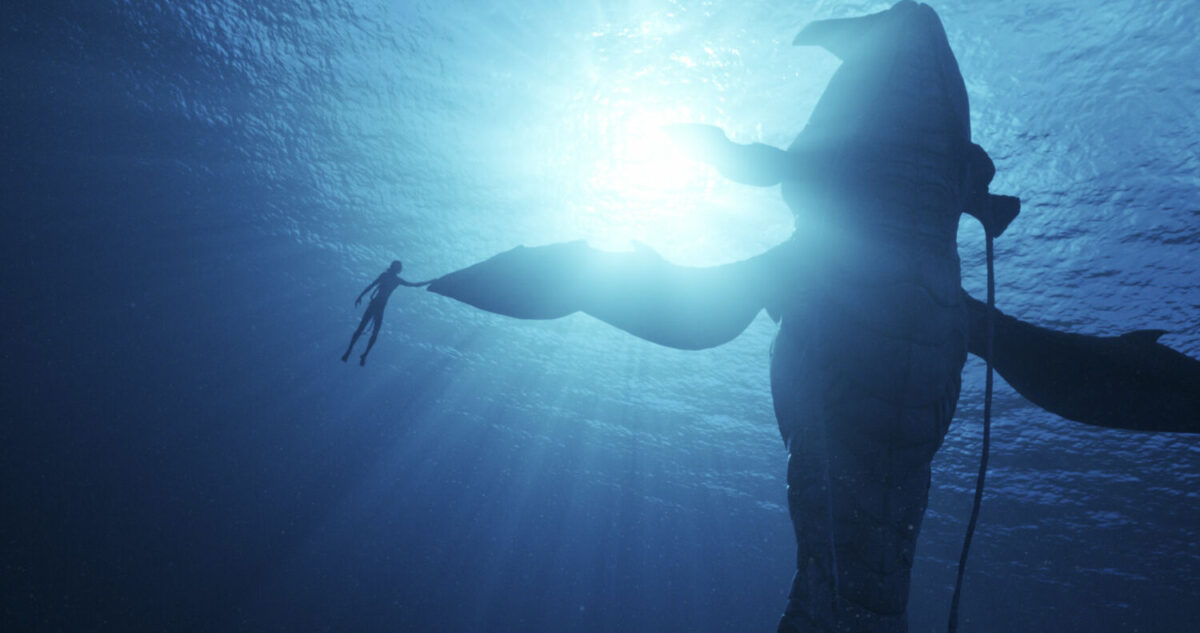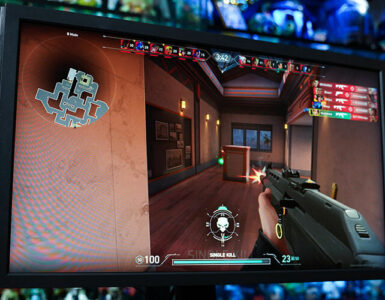Some things have to be appreciated in their intended form, and when it comes to James Cameron’s latest cinematic masterpiece, Avatar: The Way of Water, that means watching it in stereoscopic 3D.
Just as many wouldn’t garner the same level of appreciation and satisfaction from biting into a Miyazaki A5 wagyu steak from a styrofoam box with plastic utensils, driving the Bugatti La Voiture Noire at under 50 km/h, or watching a concert from behind a pair of binoculars, the same can be said for the second chapter of Cameron’s masterpiece, which is expected to cross US$500 million at the global box-office in less than a week after release.

Filmed in stereoscopic 3D and presented in the same big screen format in theatres, this 3-hour epic, starring Sam Worthington, Zoe Saldaña, Sigourney Weaver and Stephen Lang, is a sequel to the 2009 original that broke box-office records, including being the first film to bring in US$2 billion, and is currently the highest-grossing film of all time.
And much of it had to do with 3D, the much hyped fad for movie goers then, which inspired audiences to rewatch the original film multiple times, and relish in the glorious spectacle that only a cinema, and of course, James Cameron, could provide. And while 3D films have fallen out of favour in recent years, only a theatrical tour de force, guided by a film auteur, can resurrect the format, and the Avatar sequel has both.
The film, which brought in over US$435 million in its opening weekend, saw demand fueled by 3D. In North America, an estimated 58% of moviegoers purchased 3D tickets, while that figure rose to 66% internationally. But nothing can beat China, a country that simply adores Avatar, as an estimated 99% of all moviegoers caught the film in 3D.
In Singapore, the film, which brought in S$2.6 million across the opening week, also saw strong 3D demand, with 25.6% of the box office share generated from 3D, including IMAX 3D. Yes, it might fall below 3D demand from the rest of the world, but it still beat the IMAX 3D and 3D demand for Marvel Studios’ Avengers: Endgame, Avengers: Infinity War and Star Wars: The Force Awakens.
One reason is simply supply – there are only five IMAX halls in Singapore (JCube, Jewel, Lido, PLQ, and Waterway Point) and with an extended runtime of over three hours, it hasn’t been easy getting tickets, much less in 3D.
If you’re thinking that 3D is superior to 2D, and are wondering about the difference between IMAX 3D and standard 3D, that’s where you’ll need to understand the technology.

A larger portion of Avatar: The Way of Water was natively filmed in Dolby Vision 3D, at 48 frames per second, to achieve high frame rate or HFR. Since normal movies are presented at 24 frames, this makes the HFR content appear more crisp and clear.
You can also watch the film in several formats – IMAX 3D With Laser, IMAX 3D, Regular 3D and 2D, and suffice to say, watching it in 2D should be your last and final option, as you should always catch a film the way the filmmaker intended – shot and edited on 3D, as this is what was conceived by Cameron.
IMAX 3D is likely the preferred 3D format, due to the screen’s larger size for that more immersive experience, but there’s also the lesser known but more impressive IMAX Laser 3D. The laser projection is tuned to each specific hall, and creates a brighter image to compensate for the dark glasses, for a better 3D experience. Laser has a wider dynamic colour range than traditional Xenon projectors. Of the five IMAX halls here, only Lido, Jewel and PLQ IMAX halls are equipped with the new laser projection, and in HFR.

Having caught the film in both regular 2D (Golden Village VivoCity) and IMAX Laser 3D (Shaw Lido), there is no doubt that if you intend to catch up on the adventures of human Jake Sully and his Na’vi wife Neytiri, it should be in the best format available.
Cameron created Avatar from scratch, solidifying the ideas in his head through cinematic technology, and waiting for digital technology to catch up, before he could turn his thoughts into reality. There is nothing quite like the planet Pandora, with its rich, dense but enthralling forest, and now, the deep vast oceans that form the rest of the previously unseen planet. By filming his actors underwater, and then creating the visuals, everything from Pandora needs a deeper viewing.
When the Na’vi ride a skimwing as dart through the air before entering the water in one sharp motion, the realistic motion and movement of objects in the air and underwater are small supporting elements that your mind registers as utterly believable, and the illusion of immersion is forever sealed when you see the skimwing glide across the screen in 3D glory that no other film has or can ever provide. It’s like asking you to taste food, without allowing you to smell what’s cooking – the overall experience is a combination of the different elements and 3D is an intrical part of it.
In regular 2D, the difference in presentation is like night and day. Maybe it’s unfair to compare a viewing in Lido IMAX 3D with Golden Village 2D, but with the film still fresh, we were able to identify stark differences in visual presentations.

Within the first 20 minutes when man returns to Pandora, huge space arks descend upon the planet, as machines roll and trot out of the hulls. These giant mechanical monstrosities are terrible machines of doom, and even as they roll past regular size humans, the sense of scale is frightening but on 2D, it’s like watching Thanos’ army prepare for the battle of Wakanda – you understand the threat but are simply following the visuals along.
In glorious 3D, the burning fire in the foreground matched against the terrible beasts in the background rekindles in you the stories of colonisation, where invaders prey on the less industrial population, and the scale of this planetary incursion is apparent.
When the Sulleys visit the Metkayina and spend time in the ocean, the vastness of the sea and great depths is overpowering, as you see the inhabitants on their sea creatures traversing the great wide open. Every movement is fluid and as the audience, you feel wrapped up by the water. IMAX 3D envelops your senses, and as the bulk of the film is in the water, imagine watching this in plain 2D.
The 2D version is just boring and uninspiring, with flat visuals and a ho-hum sense of scale. But the biggest difference is in the blurry motion.
Cameron also prepared the film in 48 frames, instead of the regular 24 frames, and this HFR makes some of the CGI action much smoother for the brain and eyes to process. Folks who complain about getting a headache in 3D tend to fall into two categories – those who sit at an angle towards the screen such that their minds cannot accurately process what they are seeing from the angle they are seated at, as their brains struggle to decipher the CGI effects at 24 frames.

But this is not Cameron’s first rodeo, and of all the acclaimed filmmakers out there, few have his track record of merging the craft and technology of filmmaking – he is the first director to embrace 3D with the original, showing a level of stereoscopic skill that has been unmatched, and the one who has got it right when it comes to using technology to create great visuals for the story.
Just like flipping the corner of a book and watching a dot drawn on each page, but at a slightly different placement, to form the idea of the moving dot, your brain tries to connect each page with the dot, to generate the illusion of movement. With Hollywood, each frame requires an investment in CGI technology, so at times, short cuts are used and not every frame is rendered in great detail and as your brain tries to connect the visual cues, headache sets in.
Avatar: The Way of Water is not presented at 48 frames HFR in 2D, and this impacts the way the movie is seen. More frames provide greater details and without it, the experience is lost.
Here’s the kicker – not all 3D versions offer HFR as well. Geek Culture understands that Shaw Lido, Jewel, PLQ and Waterway Point offer IMAX 3D with HFR, but JCube IMAX plays the standard 24 frame IMAX 3D version. And only Jewel and PLQ Lumiere halls are playing the HFR 3D version, while the other Shaw halls offer the standard 3D one.
Your best bet, before buying any ticket, is to reach out to your favourite cinema chain offering 3D screenings, to check if they are using the HFR 3D or regular 3D copy. Otherwise, you’ll be missing out on the best experience, without even realising it.












